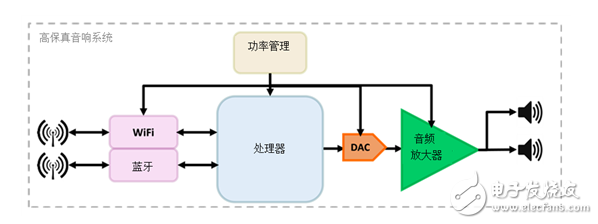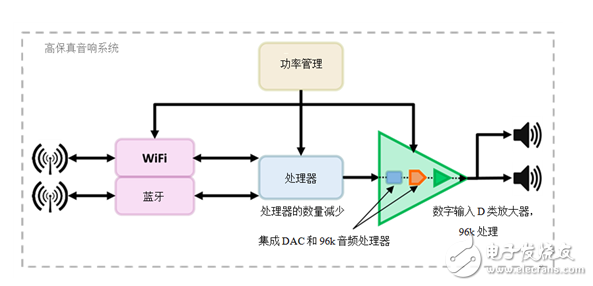In response to customer demand for top audio quality, audio system designers are working on high-resolution or high-definition (HD) audio because more and more mid-range system buyers need high-definition audio performance that was previously only available in high-end systems type. In the past, the 44.1kHz CD quality sampling frequency was sufficient for most markets, but today (and for the foreseeable future), the demand for high-fidelity sound will only continue to grow. According to professional and consumer audio equipment companies, a higher sampling frequency captures and reproduces a wider frequency range. The reproduction of audio frequencies greater than 20kHz, including ultra-high frequency harmonics, gives the characteristics of subtle components of sound (especially acoustic instruments). According to these audio equipment companies, there are some technical advantages that make it worth turning to higher sampling frequencies, for example due to the use of steep filters during digital-to-analog conversion or analog-to-digital conversion to reduce unnecessary side effects. Simply choosing an off-the-shelf music player will not honor the promise of high-resolution audio, which requires specialized hardware to truly enjoy its rich content and subtleties. Of course, not every audio file or media is recorded in high-definition audio. As with every high-performance design, the entire audio signal chain is processed in a system-wide manner, ensuring a powerful and high-performance solution. Because every link in the audio signal chain is important, make sure it does not have the weakest link. Each link must be able to meet all design target specifications, such as performance, cost, time to market, and ease of use. Figure 1 shows the basis of the HD system. Figure 1: HD audio system The power management module provides the correct power level for the Wi-Fi® speaker circuit. It is assumed that the application is powered by the system (not battery power) and depends on the output power. The power supply not only needs to provide the voltage and current required to meet the system power requirements; it also needs to provide a clean and stable power rail to prevent any power supply noise from entering the audio System and reduce audio quality. The connection module uses Wi-Fi or Bluetooth® to provide wireless communication to the system through a computer, smartphone, tablet or wireless-enabled product. Standard Bluetooth modules today provide an integrated solution for portable audio systems because they natively support wireless and wired audio. But because lossless high-resolution audio streams require higher bandwidth, their limited bandwidth constitutes a potential bottleneck. The new Bluetooth audio encoding technology promises to increase bandwidth to support high-definition audio. On the other hand, Wi-Fi includes greater network capacity, powerful signaling, and a wider radio frequency range. Its increased bandwidth capacity and system throughput make it more suitable for high-definition audio applications. The processor performs various audio processing functions, such as decoding and signal equalization, and also handles the Wi-Fi and / or Bluetooth communication software stack. In the past, CD-quality sampling frequencies may have been sufficient. But today's high-fidelity audio systems impose other requirements on the processors in the signal chain, because high-fidelity sound quality requires sampling rates in the range of 48kHz to 192kHz in a 24-bit music signal stream. The audio module contains all the electronic equipment needed to drive the speakers in the system. Because the signal from the connection module and the processor has low voltage and low current capability, the audio amplifier provides the necessary higher voltage and current capability for the signal to drive the driver in the speaker system. The module may include an audio digital-to-analog converter (DAC) for converting digital audio signals from the processor into analog audio signals, and provide other audio processing in the digital domain to further enrich the customer experience in high-end systems. Another key component of the audio module is the audio amplifier. When choosing the best audio amplifier for your HD audio system, you have two options: Class AB or Class D. Class AB audio amplifiers are linear amplifiers that do not require many external electronic components. But they are extremely inefficient and require a lot of passive or even active thermal management in the form of heat sinks and fans. On the other hand, Class D audio amplifiers are highly efficient switching amplifiers that require little thermal management, but they require output inductors. For many years, amplifiers in high-definition audio have been class AB amplifiers. Audio Class D amplifiers are considered non-compliant because they do not meet all the requirements for HD audio; they no longer exist today. TI's latest generation of Class D amplifiers establish a symbiotic relationship with the digital engine, while effectively transmitting enhanced audio quality to speakers, improving the overall performance and efficiency of high-definition audio systems. Optimize HD audio design High-performance high-definition audio amplifiers with integrated DAC and processing functions, such as TI's new TAS5782M, can help audio designers greatly simplify design, reduce costs and shorten design cycles. The integrated DAC helps reduce system complexity by providing a way to connect the audio amplifier directly to the processor, ensure maximum signal integrity, and reduce the number of components. Integrated audio processing can greatly reduce the cost and computing requirements of the main application processor by offloading all audio processing into the amplifier itself. You can further reduce the cost and size by reducing the cost and size of the main processor. Figure 2 is a block diagram of optimization. Figure 2: Optimized HD audio system Have you designed a high-definition audio system? If so, what specifications are most important to you? Log in and comment, or visit the Texas Instruments Online Support Community Audio Amplifier Forum. Residual Current Circuit Breaker
RCCB named Residual Current Circuit Breaker. When there is human electricity shock or if the leakage current of the line exceeds the prescribed value, Residual current circuit breaker/RCCB(without over-current protection) will cut off the power rapidly to protect human safety and prevent the accident due to the current leakage. The rccb switch which made from Korlen electric can be used as infrequent changeover of the line in normal situation.
Korlen electric ---- the rccb switch manufacturer,produces types of Residual Current Circuit Breaker. It is applicable to industrial site, commercial site, tall building and civil house.
Residual Current Circuit Breaker,Ac Residual Current Circuit Breaker,Miniature Residual Current Circuit Breaker,Residual Current Electrical Circuit Breaker Wenzhou Korlen Electric Appliances Co., Ltd. , https://www.zjmannualmotorstarter.com
